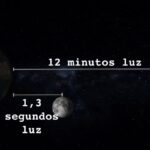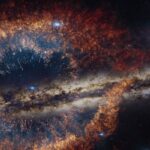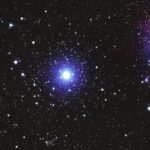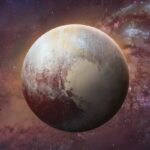We explain what the Milky Way is and what the characteristics of this galaxy are. In addition, we tell you how it was formed and what its structure is like.

What is the Milky Way?
The Milky Way is the galaxy of which the solar system is a part, that is, the galaxy where the Earth is located. It consists of a gigantic group of stars, planets and gas clouds in the shape of a barred spiral and an average diameter of around 200,000 light years. At its center lives a supermassive black hole, whose gravitational force keeps star clusters in a stable orbit.
It is possible to perceive the Milky Way with the naked eye on a clear night, as a blurry white light that extends around the celestial sphere. This is because The solar system is located in a region away from the center approximately 25,766 light years (about 7900 parsec), in one of the arms of the spiral. It takes the Sun 225 million Earth years to complete one revolution around the galactic center.
On the other hand, the Sun is just one of the hundreds of billions of stars that make up the Milky Way. These are, for the most part, dispersed individually or in pairs, but there are also important accumulations of stars known as globular clusters (some closed and compact, others open and more dispersed), some of which exceed the size up to 50 times. brightness of the sun.
It is estimated that in total the galaxy has a mass equivalent to 1012 (that is, 10,000,000,000,000) times that of the sun, and which is just one of a set of 40 galaxies known as the Local Group.
For the rest, the nature of the Milky Way continues to harbor numerous mysteries for astronomers and astrophysicists, partly due to its immensity and also because a dense layer of space dust obscures direct observation of the galactic center, making it only possible to study it at through radio wave telescopes and infrared telescopes.
See also: Astro
General characteristics of the Milky Way
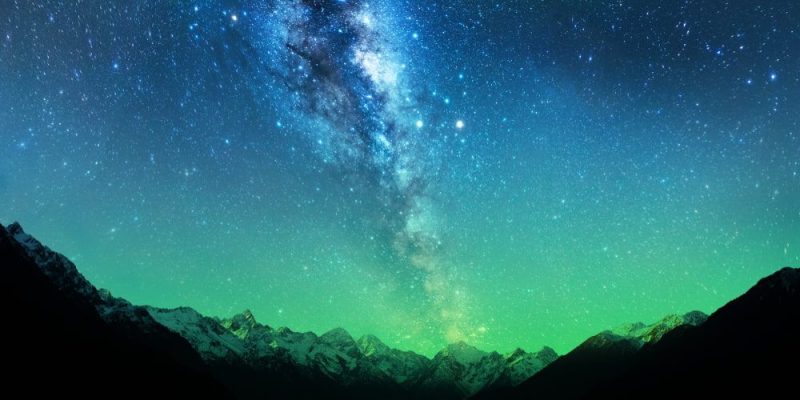
A general look at the Milky Way reveals the following characteristics:
- It is shaped like a flat spiral, approximately 200 thousand light years long (the first measurements in 1917 attributed it to half) but only a thousand light years thick. However, recent research indicates that the spiral progressively deforms and twists as it moves away from the galactic center.
- It is made up of between 100 and 400 billion stars the oldest is around 13 billion years old, just 600 thousand years younger than the rest of the galaxy.
- The solar system takes 225 million years to orbit the galaxy. Since its formation, it has completed 18 revolutions, so the Earth is only 18 galactic years old.
- At the heart of the galaxy is a supermassive black hole known as Sagittarius A whose mass is 4 million times that of the Sun and which was directly observed for the first time in 2022.
- Absolutely All the stars that can be seen with the naked eye at night belong to the Milky Way. The name of the galaxy comes from Roman mythology.
- It is estimated that in about 4 billion years, the Milky Way and the Andromeda Galaxy its closest neighbor in the Local Group, they will end up merging in a single, massive galaxy.
Structure of the Milky Way
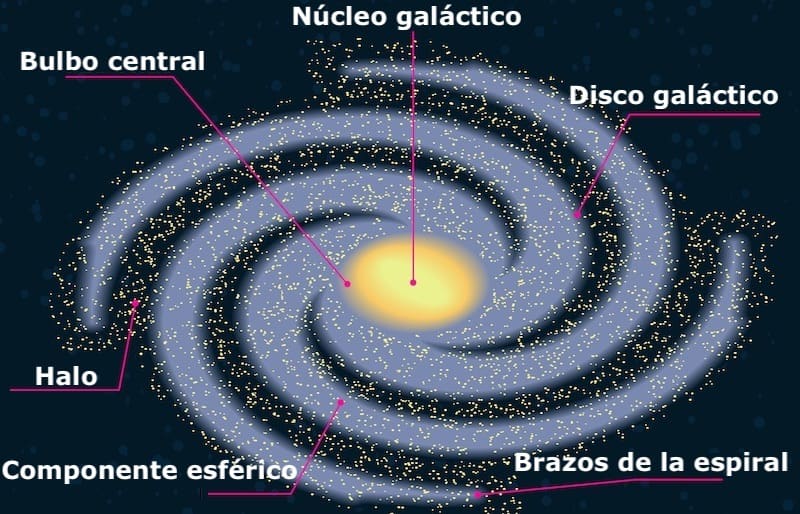
The Milky Way has a fairly common structure among known galaxies, most of which are spiral-shaped. Its components can be organized into six different sections, which are:
- The galactic core. It is the heart of the galaxy, composed of a supermassive black hole (Sagittarius A) and an accretion disk that surrounds it, that is, a cloud of gas at very high temperatures. It is a region of high energy activity and powerful emissions of infrared and X-ray radiation, due to the rapid movement of gas clouds.
- The central bulb. It is the spherical region close to the galactic nucleus, densely populated by population II stars, that is, by old stars of low metallicity. The galaxy's major globular clusters are found in this region, and can be observed optically as they protrude from the galaxy's stellar dust cloud.
- The galactic disk. It is the region that extends from the galactic nucleus to about 75 thousand light years away, and is the most visible and obvious region of the galaxy. This is the massive and bright set of stars that precede the appearance of the spiral arms, often divided into a thick disk, of old stars and a high density of matter, and a thin disk, of low density and younger stars.
- The arms of the spiral. It is the outer set of “arms” or appendages of the galaxy, which give it its spiral shape. This shape is not easy to observe with the naked eye and was not confirmed until 1953, although it remains difficult to understand from a practical point of view. Each spiral has a different name: the Perseus arm, the outer arm, the scutum-centaurus arm, among others.
- The galactic spherical component. It is an extension of the central bulge above and below the galactic disk, remotely spherical in shape and populated almost exclusively by outer globular clusters, scattered stars and dwarf stars devoid of heavy materials.
- The galactic halo. It is the least understood component of the galactic structure, exterior to its visible portion, and consisting of a spheroidal portion of space surrounding the galaxy. It has an immense amount of dark matter, the mass of which has a notable effect on galactic rotation. It is thought to extend 100,000 light years from the center and to have an amount of mass equivalent to that of the rest of the galaxy.
Formation of the Milky Way
The Milky Way is thought to be one of the oldest galaxies in the known universe, as many of its globular clusters contain some of the oldest known stars. The formation of the galaxy took place around 12 or 13 billion years ago an age very close to that estimated for the entire cosmos, and had its beginning in the material of the globular clusters that make up the stellar halo.
However, the Milky Way It gained greater complexity and density through its encounter with other smaller galaxies, which ended up merging with it. In fact, the galaxy is currently partially devouring the mass of other satellite galaxies, such as the Large Magellanic Cloud and the Small Magellanic Cloud.
Why is it called the Milky Way?

The name of the Milky Way comes from Greco-Roman mythology and In Latin it means “milk path”, since according to the myth it is the breast milk spilled from the breast of the goddess Hera (Juno, for the Romans), when she breastfed the mythical hero Heracles (Hercules, for the Romans).
In Ancient Greek astronomy, however, it was already suspected that it was a cluster of distant stars whose combined brightness made them visible. The Greeks called it the “milk circle” (kiklos galaxies) and they considered it one of the 11 circles that make up the firmament.
The mythological story of the formation of the Milky Way was represented in the painting The birth of the Milky Way (1636) by the Flemish painter Peter Paul Rubens.
The Local Group
The Milky Way is part of the Local Group, a set of around 40 different galaxies, among which there are three notable for their great brightness and large size:
- The Andromeda galaxy.
- The Milky Way.
- The Triangle Galaxy.
The rest are satellite galaxies that orbit more or less freely, and make up three clearly distinguishable galactic systems. The Local Group It has a diameter of about 10 million light years and a total estimated mass of 2.3 to 0.6 x 1012 times that of the Sun.
The Local Group, in turn, is part of a Laniakea supercluster (from Hawaiian for “immeasurable heavens”), where around 100,000 nearby galaxies are found. It was formerly considered to be part of the Virgo supercluster, but the latter is today understood as a small lobe of Laniakea.
Continue with: Planets of the solar system
References
- “Milky Way” on Wikipedia.
- “11 things you didn't know about the Milky Way” in National Geographic Spain.
- “Milky Way: the new map that reveals that our galaxy is 'deformed' and 'twisted'” on BBC News Mundo.
- “The first image of Sagittarius A*, the black hole in the center of the galaxy, has been taken” in El País (Spain).
- “Mily Way Galaxy (astronomy)” in The Encyclopaedia Britannica.

